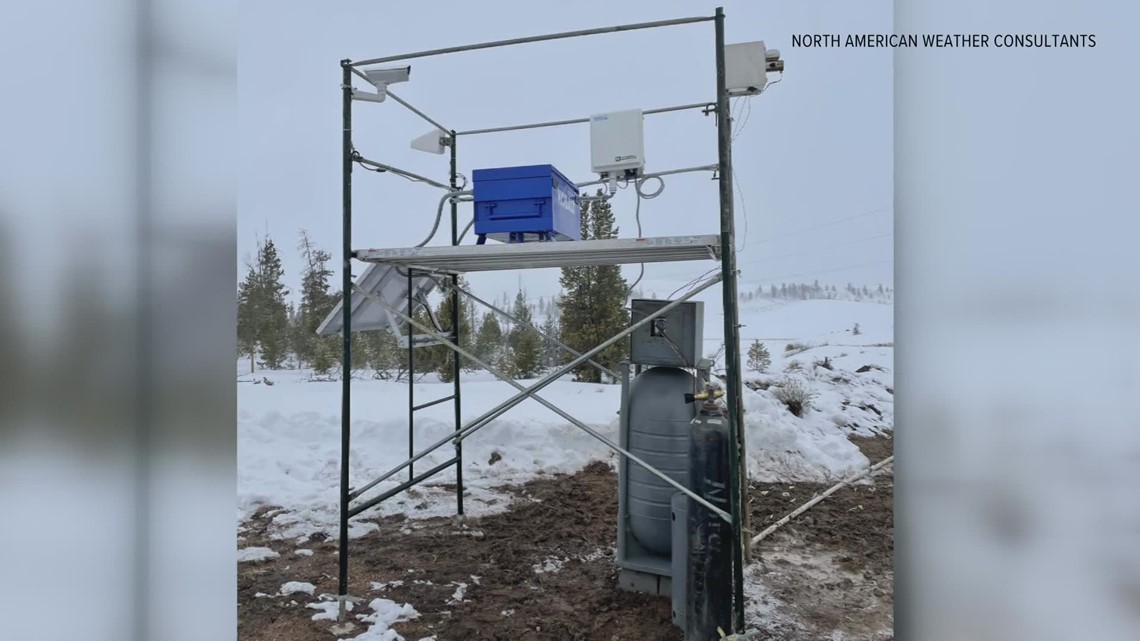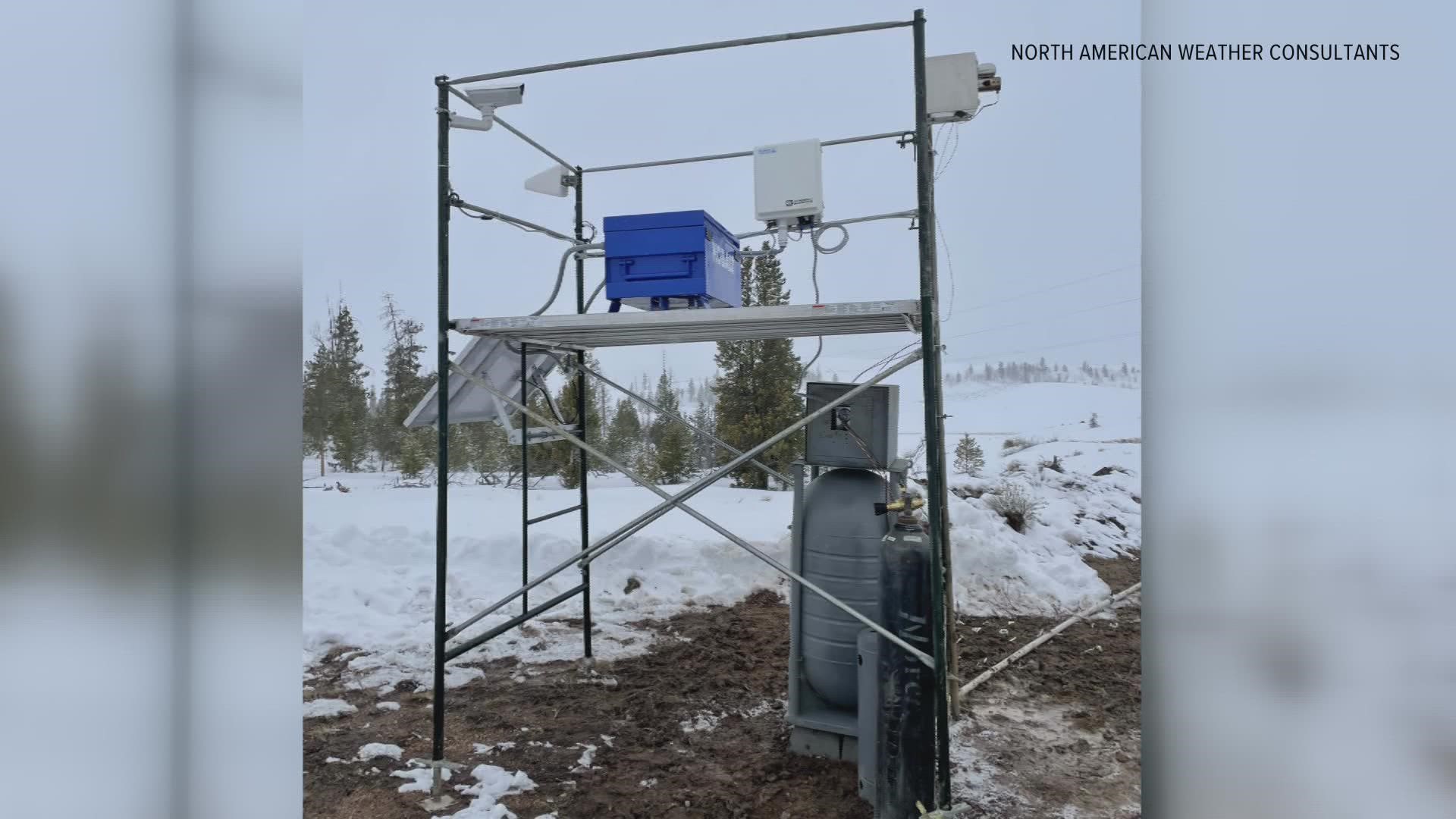BOULDER COUNTY, Colo. — Cloud seeding may be gaining momentum in Colorado as the water crisis in the western United States continues to deepen.
A new operation is getting set up along the St. Vrain headwaters west of Longmont, and it's scheduled to begin this winter.
Humans can’t create storms, at least not with our current technology, but when Mother Nature does bring them our way, we can help those storms produce extra snow by cloud seeding.
Spaying tiny crystals, called silver iodide, into a snowstorm provides more particles for snowflakes to form around.
Silver iodide can also produce snowflakes at warmer temperatures than it takes for water crystals to create snow. That taps into a whole different part of the storm that would normally not produce snow.
"Snowstorms are actually pretty inefficient at producing precipitation," said Garrett Cammans, President of North American Weather Consultants. "All cloud seeding does is help improve a storm's efficiency."
The science
Cammans said the water droplets in a storm cloud are supercooled, which means they are below freezing but remain in liquid form. The air temperature in the cloud often has to get down to -17°C to -20°C (1°F to -4°F) before those supercooled water droplets can form ice crystals instantaneously on their own, which ultimately allows a snowflake to grow.
Otherwise, snowflake crystals need a solid particle, called a condensation nucleus, to come in contact with the supercooled water and cause ice formation to happen.
Condensation nuclei can be anything -- pollution, smoke, dust and even insects. But scientists in the 1960s discovered that silver iodide makes for a very efficient condensation nuclei that can form ice crystals at temperatures as warm as 17°F to 25°F.


The shape and structure of a silver iodide crystal is very similar to a water ice crystal. Cammans said that naturally aids its attraction to the supercooled water droplets.
"Silver iodide is also unique in polarity," he said. "There is a strong electric attraction between it and a water molecule."
He also said the silver iodide particles mix out of the snowflake quickly and are not hazardous to plants and animals.
Reseach projects over the years have shown that the concentrations of silver iodide near cloud seeding operations were below the EPA health standard, but there has not been a comprehensive study about the long-term buildup of silver iodide in water supplies or river channels.
“So silver iodide just tends to be really effective," Cammans said. "It’s also very safe, very non-impactful from an environmental standpoint. Silver is completely biologically inert.”
The results
Cammans said North American Weather Consultants already runs a cloud seeding operation along the upper Gunnison River. The new operation in Boulder County could be one of the first on the Front Range.
He said the goal is to produce 10% additional snowpack in that river’s headwaters. Independent studies in some of their other operation areas, in Colorado, Utah and California, have shown that cloud seeding can produce an additional 350,000 acre-feet of runoff.
He said that's a relatively small but not insignificant boost to winter snowpack, especially as the water crisis in the West gets more and more dire every year.
“So, we’re not stopping a drought by cloud seeding, but it is a helpful, beneficial resource," Cammans said.


He said that not only means more water available for municipal consumers, but it could also mean a 10% longer growing season downstream of cloud seeding. It could mean healthier soils in the river basin, allowing for vegetation to flourish and be more resistant to wildfire spread.
"And power is a huge impact," Cammans said. "Lake Powell and Lake Mead are both at historic lows, which is threatening the power production in the entire West."
He said power companies often contribute financially to cloud seeding operations along with farmers and ranchers, ski resorts and city and state water agencies.
The St. Vrain and Lefthand Water Conservancy District is the main sponsor behind the new Boulder County operation.
He said cloud seeding in Colorado is also gaining momentum from agencies downstream of our rivers. For example, the state of Nevada is funding some of its own operations on the Colorado River.
Misconceptions
Cammans said one of the biggest misconceptions about cloud seeding is that it creates clouds or storms, when it actually seeds precipitation in storms that are produced naturally in the atmosphere.
He said another common misconception is that cloud seeding steals precipitation from areas downwind of the operations. But, he said, there’s more moisture in a storm than most people realize, and very little of that moisture actually falls as precipitation.
He said a typical storm will only dump about 10% of its moisture on a particular watershed. Cloud seeding only takes an additional 10% of that 10%.
“Still leaving 89% or 89.5% of its moisture for the next watershed over," he said. "So, we’re not in a situation where I see any risk of robbing Peter to pay Paul."
He also said many people think cloud seeding is too expensive for the little results.
"Our cost analysis puts the water that we produce at $4 to $20 per acre-foot depending on the area, the treatment and the terrain," he said.
He said that price would be a bargain compared to some other methods of increasing the water supply, like desalinization, which can cost between $400 to $1,000 an acre-foot.


Another popular misconception is that the contrails people see in the sky are chemtrails left by cloud-seeding operations.
He said while aircraft are a very effective way to deliver silver iodide directly into a storm system, those jet engine contrails are not from cloud seeding. That is simply condensation from engine exhaust.
The big giveaway here is that it would be a complete waste to try to cloud seed in clear skies. Again, cloud seeding cannot create clouds -- it creates additional precipitation inside clouds that are already there.
When a silver iodide is delivered by aircraft, the sky would be overcast because of the storm and people would not be able to see the plane or the seeding candles.
He said all of the NAWC cloud seeding operations in Colorado are ground-based. Aircraft delivery is much more expensive, mainly due to the cost of jet fuel.
SUGGESTED VIDEOS: Colorado Climate

